If you needed more proof that brevity is the soul of wit, you need to check out some of the animated shorts selected to screen at the Annecy festival, which make us laugh, shake us up and speak volumes about the human condition in just a few minutes. We caught up with a few of the brilliant animators behind some of the shorts featured at the 2019 event to find out more about their inspirations, methodology and takes on the artform. Keep an eye on them as their projects continue to dazzle audiences both online and at festivals worldwide!
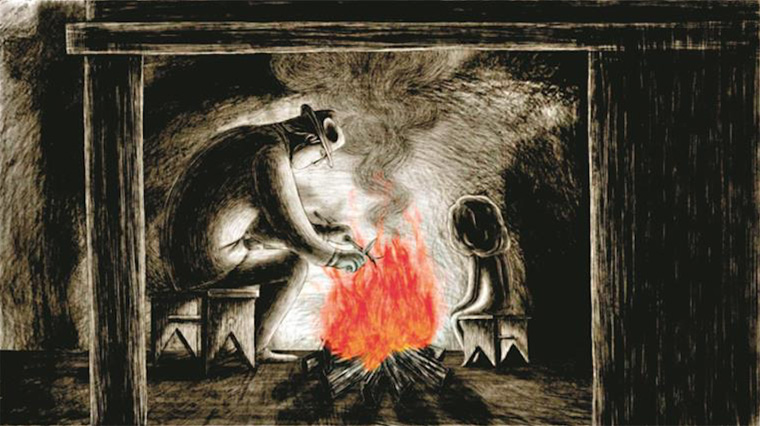
Tio Tomás
By Regina Pessoa
(Canada, France, Portugal)
Director Regina Pessoa’s 2006 short Tragic Story with a Happy Ending won the top prize at Annecy in 2006. She’s back this year with another amazing project: Tio Tomás (Uncle Thomas), a short that was inspired by the memories of her own uncle. “I had a special affection for him, because it was with him that I started drawing on the walls of my grandmother’s house, where he lived,” Pessoa tells us. “He was considered a marginal person because he didn’t follow the standard norms of being a man— to raise a family, work, competition. But he was a good man who was kind and generous to his nieces/nephews.”
Pessoa says everything that happens in the short actually happened in real life. “He had experienced misfortunes and that had broken him, which accentuated his obsessive character,” she notes. “I always asked myself, ‘Why can’t my Uncle Thomas be celebrated as he is?’”
Tio Tomás was produced by Abi Feijó, with a budget of about 400,000 euros (about $449,000) in a 22-month period. The short is a co-pro between Ciclope Films (Portugal), NFB (Canada) and Les Armateurs (France), with the participation of exec producer Phil Davies (Peppa Pig). Pessoa used mixed media to create the animation.
“I wanted to keep developing my personal 2D animation style, but I also wanted to animate some scenes with real drawings on the walls and to make some stop motion as well,” she notes. “So, my ambition was to combine all these different techniques and visuals and create an aesthetic coherence between all these media. I used Photoshop for all the 2D animation and also for its integration with the stop-motion scenes.”
Pessoa says she will never forget the first time she saw Charlie Chaplin’s The Gold Rush at a small theater in her small village in Portugal. “When he ate his own boots with such relish, I whispered to my sister, ‘It’s chocolate!’ It was my first film … what a great introduction to cinema!”
What does she hope audiences to take away from her short? “I once heard someone say, ‘We all have a half-crazy uncle.’ I think this is true and my film, although it talks about my unique and singular Uncle Thomas, I suppose a lot of people will recognize their own peculiar loved one. I wanted to show that it’s not necessary to do extraordinary things to be important in our life. That’s a motto I truly believe in.”

Toomas Beneath the Valley of the Wild Wolves
Chintis Lundgren
(Estonia, Croatia, France)
Fans of Chintis Lundgren’s Cristal-nominated 2017 short Manivald will be happy to know that the popular repairman from that film is starring in his own short this year. “Toomas came to be as a side character in Manivald, and he seemed interesting enough to have a film of his own. We (me and my co-writer Draško Ivezić) looked at him and tried to think, why is this hot washing machine repairman going around and seducing everyone? How does this work out with also having a wife and kids at home? Was fixing machines always his job or is he doing this for some other reason? There was a lot of mystery and possibilities around him and that was very inspiring for me!”
The Estonian animator says she was also inspired by the sexploitation movies of Russ Meyer. “After the very quiet and held-back film about Manivald, I wanted to make something more crazy and wild, so I decided to play around with B-movie conventions. Of course, Meyer’s movies have a lot of boobs, I concentrated more on wolf-butts!”
After coming up with the short’s concept in November ’17, Lundgren and her co-writer spent about a year composing and polishing the story. “I thought the layout would never get done because we made so many changes to the script after starting production,” she recalls. “Finally, the animation had to be done very quickly because there was no more time left. Altogether, from concept to final image, it took us a year and a half.”
Lundgren says she’s trying to create a universe of characters, and wants her films to be interconnected. “It was challenging to build this new story in a way that it fits together with everything we know about Toomas from the previous film. We would come up with some ideas that would seem cool, but if it clashed with who Toomas was and what he did in Manivald, then there was no way to keep that.”
Talking about her early influences, Lundgren says seeing the classic Priit Pärn films (Triangle, Breakfast on the Grass) as a kid, really had a big impact on her. “I also saw Norstein’s Hedgehog in the Fog so many times in my childhood that I’m sure that left a mark, too!” she notes.
Lundgren says she loves being an animator mostly because of the flexible wake-up times, and all the crazy animators she meets at various festivals. And the one thing that she would love audiences to take away from her great new film? “Fixing washing machines isn’t that simple!” she says with a smile.
Toomas Beneath the Valley of the Wild Wolves – teaser from Chintis Lundgren on Vimeo.
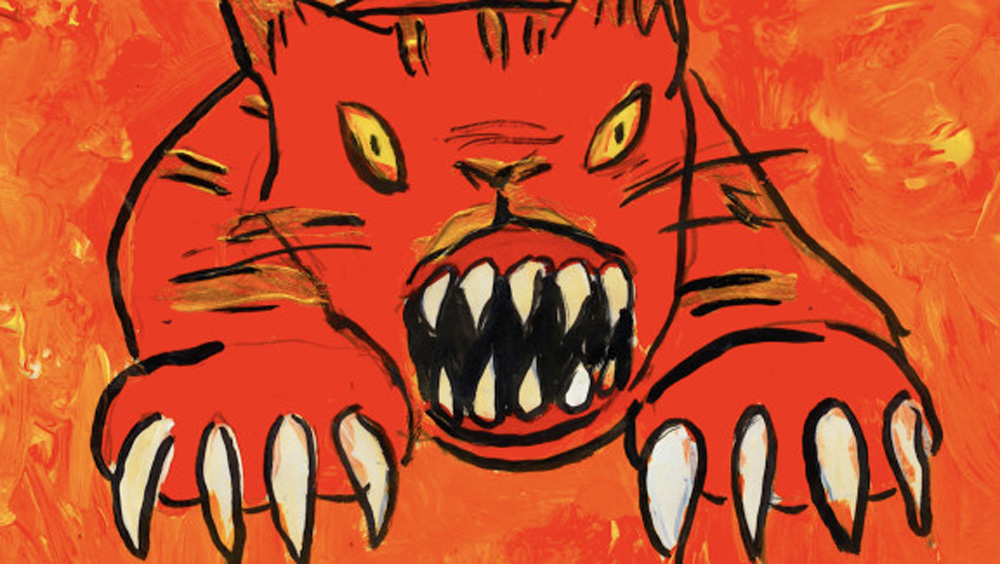
Live a Little
By Jenny Jokela
(Germany, U.K.)
After making her graduation film Barbeque, which dealt with post-traumatic stress disorder, animator Jenny Jokela knew she wanted to tackle something light-hearted. “I wanted to make something that would make me laugh, which is why I wanted to collaborate with my best friend Celia Hillo, who wrote the script for the film,” she says. “I tend to see the film as a celebration of our late teens/young adulthood, struggling with feelings of loneliness and not always fitting in with the social norms of how ‘a good woman’ should behave.”
Made for about 3,000 euros ($3,370) in about four months, Live a Little was funded by a grant that supports cultural projects by Finnish-Swedish artists. The short was fully hand-painted with acrylic paint on paper. Then, it was digitally assembled using Photoshop, After Effects and Premiere.
Jokela says the budget was so small that she had to be very efficient with her time. She adds, “Before making the film I was unsure how I would find collaborating with a writer, as I usually write my own films, but in the end I found it liberating and inspiring.”
The animator, who is a huge fan of the anime classic Paprika and the works of Nathalie Djurberg and Suzan Pitt, says she loves the sense of complete freedom and power of creation animation gives her. She adds, “And there’s always something new to learn and improve. I just hope audiences will get a little chuckle out of my short and that it brings out their own memories of their youth.”
Live a Little – Trailer from Jenny Jokela on Vimeo.

Intermission Expedition
Wiep Teeuwisse
(Netherlands)
Wiep Teeuwisse credits a beautiful hiking trip as the inspiration for her Annecy short Intermission Expedition. “I thought it was absurd to see rocks floating on water for the first time,” she recalls. “Later, I found they floated because air bubbles in volcanic rock make the material really light. On another day I watched seafoam getting blown across a beach and disappearing into thin air. This solid, old material sharing its structure with such an ephemeral substance gave me an uneasy feeling that I wanted to explore further, which eventually resulted in the short!”
The Dutch animator developed the short over an 18 month period, while the animation, sound and post-production were done in seven very labor-intensive months. “Everything was animated on paper with pencil, which is more time consuming than digital drawing,” she says. “But I find the process much more peaceful without a computer — and also, you don’t get lost on the internet as much. The backgrounds were done in soft pastel chalk, and the coloring was done digitally.”
Teeuwisse says it took her a very long time to find a balance between narrative and poetic storytelling. “Realizing that I did not need a main character was a big moment. Also, taking out 90 percent of what I’d intended to put in also helped a lot!”
The animator mentions that Don Hertzfeldt’s Everything Will Be OK had a huge impact on her. “It just has such a good balance between simple and complicated, funny and sad, accessible and strange. It puts you in this mood immediately, and it made me realize that great moments are much more impactful than a clever pay-off.”
She hopes audiences will also feel immersed in her new short as they watch it. “Maybe I’d love to hear one person say that they are inspired to live life with a little bit more attention and calm after seeing it!”
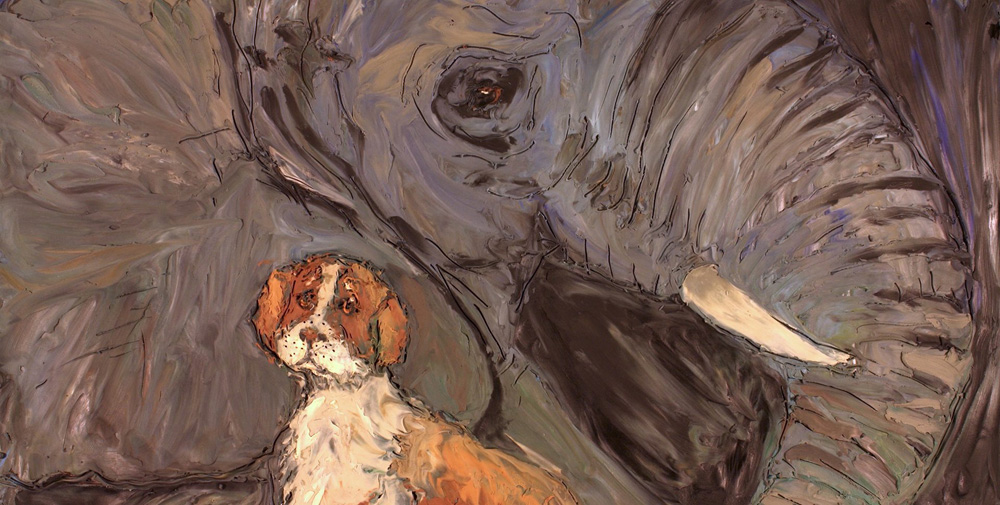
The Elephant’s Song
By Lynn Tomlinson
(U.S.)
When animator Lynn Tomlinson (The Ballad of Holland Island House) heard the story of Old Bet, the first circus elephant in America, on a podcast, she was so moved by the tragic tale that she decided to work on an animated project based on the story. “Here was a social animal and the only one of her species on the continent, all alone and unable to communicate with others of her kind,” she notes. “With Ringling Bros. retiring their elephants and subsequently closing down, it felt like a timely subject to take on.”
Tomlinson decided to tell the story from the P.O.V. of a dog in Old Bet’s menagerie and collaborated with her son Sam Saper, who wrote the lyrics and the song that make up the soundtrack of the film. The project took about two years to complete, but the big challenge was boiling down all the information that she had collected into one cohesive song.
The hand-crafted animation was created with clay-on-glass animation, where oil-based modeling clay is spread thinly on a glass sheet and moved frame by frame. “My animation is a truly independent process,” explains Tomlinson. “I animate the film alone in a home office. My only direct assistance with the animation came from my mom and my daughter. This film was a true family project. This means that the only cost is that of materials, which is almost negligible. For inspiration, I used everything from YouTube videos of elephants swimming to famous Hudson River School paintings, like The Oxbow by Thomas Cole. I also listened to 1,200 hours of books on tape as I worked on this project!”
Tomlinson counts Sesame Street and The Electric Company as some of her earliest influences. “I remember seeing Wendy Tilby and Amanda Forbis’s When the Day Breaks when it first came out,” she adds. “I have watched that film dozens of times since then, and it grows more resonant with every viewing, like a good short story.”
Looking back at the experience, Tomlinson says the project works as a great exercise in building empathy. “Old Bet’s story was a way into thinking about a complicated web of ideas, it’s not just about one historical elephant. I like telling stories from perspectives that make you walk in others’ shoes.” And why animation? “I love movement. I like thinking in three and four dimensions — painting feels too limited. I want to move around and through space. I love animating these shifts and transformations of space through the fluidity of the clay-on-glass medium.”
The Elephant's Song – Excerpt from Lynn Tomlinson on Vimeo.

The Levers
By Boyoung Kim
(S. Korea, U.S.)
Boyoung Kim’s fascinating new short centers on a man who makes a strange discovery after accepting a job offer from a stranger on the street! She says she was inspired by social phenomena from media. In fact, she says sometimes she can get inspired by seeing just one single, random photo. “I think what I love about working in animation is the ability to create a new world that never existed before,” she maintains.
The hand-drawn short, which had a $40,000 budget, took about a year to make. Perhaps that’s why Kim says her biggest challenge was time management. “Sitting at the desk for one year to create a 10 minute project is always challenging, but you have to learn to enjoy it at the same time.”
Kim says there have been too many shorts that have made an impact on her as an animator. But there was this one animated film — the title of which she can’t recall — that really stands out! “It was about a kid hiding dirty socks from his mother. At that time, I was planning to make my first animated short (Replacement, about a boy who is terrified of pulling out his loose tooth) but wasn’t sure if it was worth the time to make a film with such a small story.
“The experience with the film festival inspired me to work on the project and understand that material doesn’t matter if I have a certain message to tell. Animation can make interesting and exciting experiences from small things if you use attentive observation.”
Kim believes that audiences should form different opinions and interpretations after watching an animated short. “It’s another form of creating art” she notes.” I don’t want to interfere in what they got from my film, and I’m willing to hear a diverse range of reviews and interpretations! I just hope people have a good time when they watch it!”
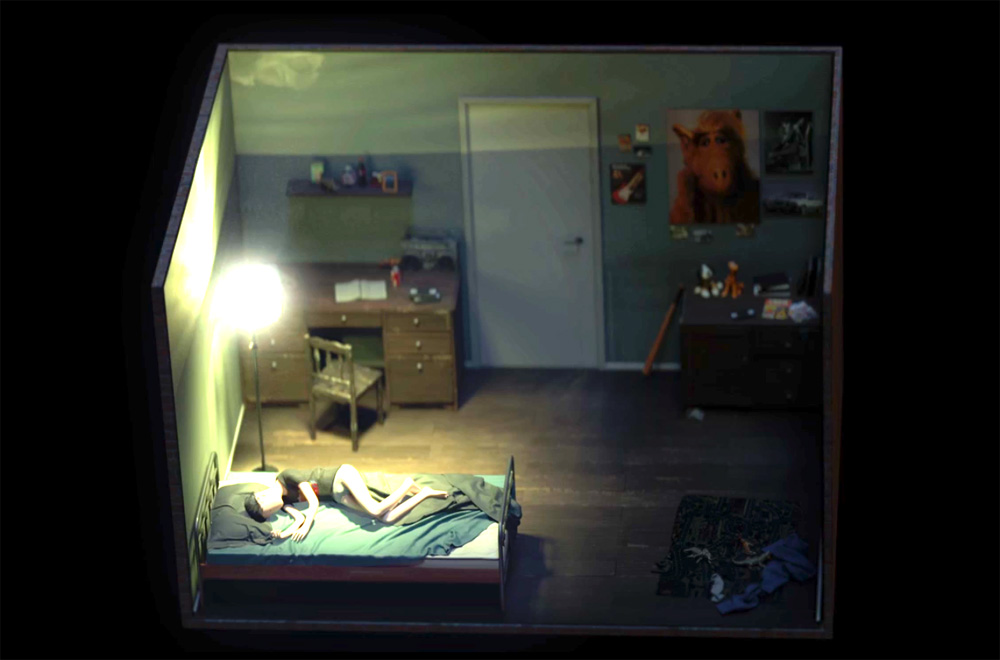
Pulsión
By Pedro Casavecchia
(Argentina)
Argentine animator Pedro Casavecchia’s short film Pulsión (Drive) deals with difficult subjects such as child abuse and dysfunctional family environments. He says an interest in true crime documentaries propelled him to tell the story of a normal person who becomes a killer, little by little. “In the beginning, the motivation to start a short film was to have a piece that could get me a job in the film industry doing visual effects,” he adds. “I was lucky enough to get that job long before I finished the production, but I decided to finish it anyway!”
It took Casavecchia about four years to finish the short, or as he puts it, about “1,500 hours.” “My budget was next to nothing,” he says. ”I used a laptop that I already owned, and the people that ended up helping me all did it for free. I used some of my vacation time to speed up the process during the last month. Overall, you could say I spent 500 pounds ($650)!”
The animation was mostly done in Maya. “I started by making a very rough sketch for every animation using 3ds Max bipeds, and then, after adjusting the timing and the actions, I moved to Maya to animate for real,” he explains. “Sometimes I recorded myself or my wife to use as reference for the movements I couldn’t find in YouTube videos. The rigs were created using Adobe Mixamo.”
Casavecchia says he hopes audiences will find Pulsión worthy of being watched more than once. “I hope they find it interesting enough to make them want to learn more about the characters and the story.” He says he finds it very rewarding to be able to click play and see his characters come to life in animation. “Every action can express a lot of meaning and the quest for that final moment is an extremely fun experience. It can be very frustrating at times, but it pays off when you see the results!”
Pulsion – Trailer 2018. from PULSION short film. on Vimeo.
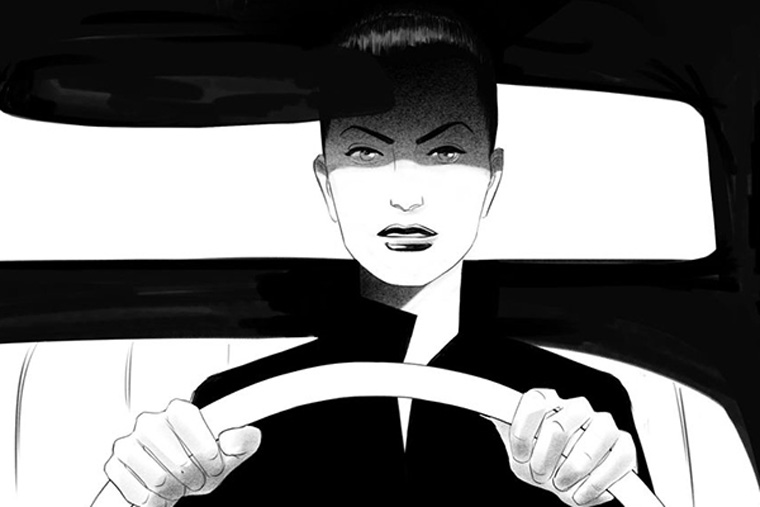
Le Cortège
By Pascal Blanchet & Rodolphe Saint-Gelais
(Canada)
Even a casual viewing of Pascal Blanchet and Rodolphe Saint-Gelais’s stunning short Le Cortège reveals that the animators are hugely influenced by the film noir era of the 1940s and ‘50s. But other influences may be harder to decipher. “I also love the silent era, and you can find the very principles of animation in silent films,” says Saint-Gelais. “Since there’s no dialogue, every idea must be shown and clarified. That lends great efficiency to the storytelling.”
“The inspiration for the content was the relationship between the trivial and the tragic, loss, cause-and-effect,” adds Blanchet. “Aesthetically speaking, it was the Golden Age of Hollywood, the great set designs in the movies of the 1940s.”
Funded by the National Film Board of Canada, the entire project took about five years to make — with two years of full-time production. The film’s budget was about $490,000, but a huge portion of that money was allocated to the music (by Pierre Lapointe), which also included two classic songs (“Don’t’ Take the Lovers from the World” and “Lullaby,” Op.1, No. 5)
Since both directors are professional illustrators, they decided to use Photoshop to create the animation. “It’s not the easiest tool for doing animation, but it definitely allowed us to stay in an environment conducive to drawing and illustration,” says Saint-Gelais. “I think it even reinforced the very ‘sculptural’ aesthetic of the film.
According to the directors, bringing out the emotion in the viewers and having it grow through the film was one of their key challenges. “We made a sad film, so there was a constant risk of that becoming boring for the viewer,” says Saint-Gelais. Blanchet adds, “I think it was to make a film that the viewer would receive at face value, and not have them bail out. To convey the emotion of the film without it being cheesy.”
The filmmakers hope that audiences will be moved by their sensitive short. Saint Gelais adds, “Secretly, our hope is that this film will appeal both to fans of animation and a broader audience of cinephiles. It depicts life as it is — non-judgmentally. That, to us, is beauty!” Blanchet concludes, “We hope it revives an idea of dramatic beauty that has maybe fallen out of favor in cinema.”






